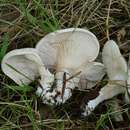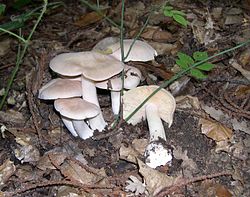mk
имиња во трошки


Entolomatàcies, també coneguts com a Rhodophyllaceae, són una família de fongs agaricals que inclouen els gèneres Entoloma, Rhodocybe i Clitopilus. La família en total conté unes 1.500 espècies, la gran majoria dins el gènere Entoloma. Tenen una distribució cosmopolita.[1]
Entolomatàcies, també coneguts com a Rhodophyllaceae, són una família de fongs agaricals que inclouen els gèneres Entoloma, Rhodocybe i Clitopilus. La família en total conté unes 1.500 espècies, la gran majoria dins el gènere Entoloma. Tenen una distribució cosmopolita.
Die Pilze aus der Familie Rötlingsverwandten (Entolomataceae) sind eine sehr artenreiche Gruppe mit mehr als 350 Vertretern in Mitteleuropa.[1]
Eine eindeutige Bestimmung der zahlreichen Arten, insbesondere in der Gattung Rötlinge (Entoloma), ist ohne Hilfe eines Lichtmikroskops kaum möglich. Wichtige Unterscheidungsmerkmale sind meist spezielle Oberflächenstrukturen der Sporen, die Beschaffenheit der Hutdeckschicht (Huthaut), die Verteilung von Farbpigmenten (z.B. ob in Vakuolen, als Inkrustationen der Hyphenwände etc.), die Form von Zystiden (wenn vorhanden) oder das Vorhandensein oder Fehlen von Schnallen.[1] In dem komplizierten Aggregat rund um den Mehl-Räsling (Clitopilus prunulus-Aggregat) ist beispielsweise das Auftreten oder Fehlen von metachromatischen Hyphen (violette Reaktion mit Brillantkresylblau) ein wichtiges Merkmal.[2]
Die ökologische Amplitude der Vertreter der Rötlingsverwandten reicht von saprobiontischen Totholz-Bewohnern bis hin zu obligaten Mykorrhizapilzen.[1]
Zu den Rötlingsverwandten zählen[3]:
Die Pilze aus der Familie Rötlingsverwandten (Entolomataceae) sind eine sehr artenreiche Gruppe mit mehr als 350 Vertretern in Mitteleuropa.
Eine eindeutige Bestimmung der zahlreichen Arten, insbesondere in der Gattung Rötlinge (Entoloma), ist ohne Hilfe eines Lichtmikroskops kaum möglich. Wichtige Unterscheidungsmerkmale sind meist spezielle Oberflächenstrukturen der Sporen, die Beschaffenheit der Hutdeckschicht (Huthaut), die Verteilung von Farbpigmenten (z.B. ob in Vakuolen, als Inkrustationen der Hyphenwände etc.), die Form von Zystiden (wenn vorhanden) oder das Vorhandensein oder Fehlen von Schnallen. In dem komplizierten Aggregat rund um den Mehl-Räsling (Clitopilus prunulus-Aggregat) ist beispielsweise das Auftreten oder Fehlen von metachromatischen Hyphen (violette Reaktion mit Brillantkresylblau) ein wichtiges Merkmal.
Die ökologische Amplitude der Vertreter der Rötlingsverwandten reicht von saprobiontischen Totholz-Bewohnern bis hin zu obligaten Mykorrhizapilzen.
The Entolomataceae are a family of fungi in the order Agaricales. The family contains eight genera and 2250 species, the majority of which are in Entoloma.[1][2] Basidiocarps (fruit bodies) are typically agaricoid (mushrooms with gills), but a minority are cyphelloid. secotioid, or gasteroid. All produce pink basidiospores that are variously angular (polyhedral), ridged, or nodulose. Species are mostly saprotrophic, though a few are parasitic on other fungi. The family occurs worldwide.
The family Entolomataceae was first introduced in 1972 by the Czech mycologists František Kotlaba and Zdeněk Pouzar to replace the earlier name Rhodophyllaceae. The latter, introduced in 1951 by Rolf Singer, is illegitimate because it is based on the illegitimate genus Rhodophyllus which includes (and is therefore a superfluous synonym of) the earlier and legitimate name Entoloma.[3] The family is well defined by its distinctive spore morphology, formed by a unique type of spore-wall thickening called the "epicorium",[2] and by recent DNA studies.[4][2]
Many different internal classifications of the Entolomataceae have been proposed. In 1871, German mycologist Paul Kummer created the genera Eccilia, Leptonia, Nolanea, and Entoloma for species with angular spores, based on perceived differences in the morphology of fruit bodies. These genera were widely used throughout the twentieth century, but DNA studies have now shown them to be polyphyletic (artificial).
The current view is that Entolomataceae with angular spores should either all be classified in the genus Entoloma, which forms a large but monophyletic (natural) group,[2] or split between Entoloma and the smaller, basal group Entocybe.[5] Species with longitudinally ridged spores are classified in Clitopilus. Species with nodulose spores are classified in Rhodocybe or Rhodophana. Species with obscurely nodulose spores (appearing almost smooth under a microscope) are classified in Clitocella or Clitopilopsis. [6]
See list of Entolomataceae genera for a table of the main genera into which the family was formerly divided.
The family has a cosmopolitan distribution and species are common in both temperate and tropical climates.[7]
The Entolomataceae are a family of fungi in the order Agaricales. The family contains eight genera and 2250 species, the majority of which are in Entoloma. Basidiocarps (fruit bodies) are typically agaricoid (mushrooms with gills), but a minority are cyphelloid. secotioid, or gasteroid. All produce pink basidiospores that are variously angular (polyhedral), ridged, or nodulose. Species are mostly saprotrophic, though a few are parasitic on other fungi. The family occurs worldwide.
Entolomataceae es una familia de hongos basidiomicetos del orden Agaricales. Esta familia contiene 12 géneros y 1.071 especies.
Dentro de las distintas especies de cada género, se encuentran algunos hongos que son comestibles y otros venenosos.
Entolomataceae es una familia de hongos basidiomicetos del orden Agaricales. Esta familia contiene 12 géneros y 1.071 especies.
Punalehikulised (Entolomataceae) on sugukond šampinjonilaadsete seltsist.
Sugukonnas on kokku üle 1500 liigi.
Punalehikulised (Entolomataceae) on sugukond šampinjonilaadsete seltsist.
Sugukonnas on kokku üle 1500 liigi.
Entolomataceae on helttasienten lahkoon kuuluva sieniheimo, johon kuuluu neljä sukua ja 1 071 lajia.[1] Heimon lajit ovat kosmopoliitteja, yleisiä sekä lauhkeissa että trooppisissa ilmastoissa.[2]
Entolomataceae on helttasienten lahkoon kuuluva sieniheimo, johon kuuluu neljä sukua ja 1 071 lajia. Heimon lajit ovat kosmopoliitteja, yleisiä sekä lauhkeissa että trooppisissa ilmastoissa.
Les Entolomataceae sont une famille de champignons basidiomycètes. Cette famille, riche de plus de 1500 espèces est présente dans le monde entier depuis les zones arctiques jusqu'aux tropicales. Très variable, tant en termes de morphologie des basidiomes que de biologie microscopique, ses espèces sont regroupées pour leur spores roses et anguleuses ainsi que par leurs lames jamais libres[1].
La systématique traditionnelle de cette famille comprend trois principaux genres agaricoïdes: Rhodocybe, Clitopilus et Entoloma ; ce dernier étant parfois divisé en plusieurs genres ou sous-genres. En outre, il existe trois autres genres non agaricoïdes et plus petits, à savoir, le genre monotypique cyphelloïde Rhodocybella, le genre sécotioïde Rhodogaster et le genre gastéroïde Richoniella[1].
Cette famille se distingue par quatre caractères précis : le chapeau non séparable du pied, des lames non libres (mais parfois sublibres), et une sporée de couleur rose à rosâtre et des spores anguleuses. Les trois genres suivants se distinguent notamment par[1] :
D'après la 10e édition de Dictionary of the Fungi[2] (2007), cette famille était constituée des genres suivants, la phylogénétique lui a ajouté les genres Leptonia et Nolanea.
Les Entolomataceae sont une famille de champignons basidiomycètes. Cette famille, riche de plus de 1500 espèces est présente dans le monde entier depuis les zones arctiques jusqu'aux tropicales. Très variable, tant en termes de morphologie des basidiomes que de biologie microscopique, ses espèces sont regroupées pour leur spores roses et anguleuses ainsi que par leurs lames jamais libres.
La systématique traditionnelle de cette famille comprend trois principaux genres agaricoïdes: Rhodocybe, Clitopilus et Entoloma ; ce dernier étant parfois divisé en plusieurs genres ou sous-genres. En outre, il existe trois autres genres non agaricoïdes et plus petits, à savoir, le genre monotypique cyphelloïde Rhodocybella, le genre sécotioïde Rhodogaster et le genre gastéroïde Richoniella.
Entolomataceae Kotl. & Pouzar 1972 è una famiglia dell'ordine Agaricales.[1]
A questa famiglia appartengono specie dalle spore color rosa di intensità più o meno variabile.
I generi della famiglia sono seguenti.
Entolomataceae Kotl. & Pouzar 1972 è una famiglia dell'ordine Agaricales.
A questa famiglia appartengono specie dalle spore color rosa di intensità più o meno variabile.
Gijabudiniai (lot. Entolomataceae) – agarikiečių (Agaricales) eilės grybų šeima.
Vaisiakūniai smulkūs, vidutinio dydžio. Kepurėlė varpelio, kūgio ir kt. formos, nuo baltos iki juodai mėlynos spalvos. Saprofitai. Išplitę visame žemės rutulyje, auga nuo ankstyvo pavasario iki vėlyvo rudens.
Lietuvoje auga 3 gentys:
Į Lietuvos raudonąją knygą įrašyti šie gijabudiečiai grybai:
Sārtlapītes (Entolomataceae) ir bazīdijsēņu dzimta, kurā ietilpst vairāk nekā 1500 sugu.[1][2]
Ir aprakstītas vairāk nekā 1500 sārtlapīšu sugu, kuru lielākais skaits pieder sārtlapīšu ģintij (Entoloma).
Patstāvīga ģints statusā:
Ģintis apakšģints statusā vai apvienotas bijušas patstāvīgas ģintis:
Sārtlapītes (Entolomataceae) ir bazīdijsēņu dzimta, kurā ietilpst vairāk nekā 1500 sugu.
Entolomataceae is een botanische naam van een familie van paddenstoelen. Volgens de Index Fungorum [24 februari 2009] bestaat de familie uit 34 geslachten.
De harde voorjaarssatijnzwam (Entoloma clypeatum) en de giftige satijnzwam (Entoloma sinuatum) zijn soorten uit de familie.
Entolomataceae is een botanische naam van een familie van paddenstoelen. Volgens de Index Fungorum [24 februari 2009] bestaat de familie uit 34 geslachten.
De harde voorjaarssatijnzwam (Entoloma clypeatum) en de giftige satijnzwam (Entoloma sinuatum) zijn soorten uit de familie.
Dzwonkówkowate, wieruszkowate (Entolomataceae Kotl. & Pouzar) – rodzina grzybów należąca do rzędu pieczarkowców[2]
Rodzina Entolomataceae jest zaliczana według "Catalogue of Life: 2009 Annual Checklist" do rzędu Agaricales i należą do niej rodzaje:
Polskie nazwy na podstawie pracy Władysława Wojewody z 2003 r[3].
Klasyfikacja przedstawiona przez "Systema Naturae 2000" umieszcza rodzinę wieruszkowatych również w rzędzie pieczarkowców (Agaricales). Zaliczane są do niej rodzaje: Clitopilus, Entoloma, Rhodocybe, Rhodocybella, Rhodogaster, Richoniella.
Dzwonkówkowate, wieruszkowate (Entolomataceae Kotl. & Pouzar) – rodzina grzybów należąca do rzędu pieczarkowców
Entolomataceae (tên gọi khác Rhodophyllaceae) là một họ nấm trong bộ Agaricales. Đây là một họ nấm lớn bao gồm các loài mọc cạn có lá tia (gill) và bào tử màu hồng. Một số chi nấm nổi bật trong họ này có thể kể đến như: Entoloma, Rhodocybe, và Clitopilus. Tổng số loài của họ nấm Entolomataceae là trên 1500 loài, phần lớn trong số đó thuộc về chi Entoloma.[1][2] Hai chi cũ là Leptonia và Nolanea nay cũng đã được xếp vào chi Entoloma. Nấm Entolomataceae thường phát triển trong những cánh rừng thưa hoặc những vùng đồng cỏ. Chúng có lá tia ở mũ nấm, một điểm khác với họ Pluteaceae cùng bộ nhưng không có lá tia.
Entolomataceae (tên gọi khác Rhodophyllaceae) là một họ nấm trong bộ Agaricales. Đây là một họ nấm lớn bao gồm các loài mọc cạn có lá tia (gill) và bào tử màu hồng. Một số chi nấm nổi bật trong họ này có thể kể đến như: Entoloma, Rhodocybe, và Clitopilus. Tổng số loài của họ nấm Entolomataceae là trên 1500 loài, phần lớn trong số đó thuộc về chi Entoloma. Hai chi cũ là Leptonia và Nolanea nay cũng đã được xếp vào chi Entoloma. Nấm Entolomataceae thường phát triển trong những cánh rừng thưa hoặc những vùng đồng cỏ. Chúng có lá tia ở mũ nấm, một điểm khác với họ Pluteaceae cùng bộ nhưng không có lá tia.
Entolomataceae Kotl. & Pouzar, 1972
СинонимыЭнтоломовые (лат. Entolomataceae) — семейство грибов порядка Агариковые (Agaricales).
Некоторые виды ядовиты или смертельно ядовиты, другие, например Clitopilus prunulus, съедобны.
Сапротрофы или микоризообразователи, некоторые виды произрастают на навозе или во мху. Встречаются как в лиственных, так и в хвойных лесах.
Энтоломовые (лат. Entolomataceae) — семейство грибов порядка Агариковые (Agaricales).
Некоторые виды ядовиты или смертельно ядовиты, другие, например Clitopilus prunulus, съедобны.
见内文
粉褶菌科(Entolomataceae)是担子菌门下伞菌目的一科。

本文参照
イッポンシメジ科(イッポンシメジか、Entolomataceae(旧: Rhodophyllaceae))は、ハラタケ目に属する科の一つ。
イッポンシメジ科は、枯草や枯葉上に生えるキノコの集合で、世界的に14属が知られている。主なものに共通する特徴として、胞子の形が角張った形をしていることがある。この子実体は様々な型のものがあり、一目でイッポンシメジ科の種であると判断するのは難しい。多くの種が毒をもっており、この科のキノコに含まれるものに似たキノコを採取するのは避けたほうが良い。
この分類は古い分け方であり、現在ではDNAによる分類で別な科に組み込まれている。